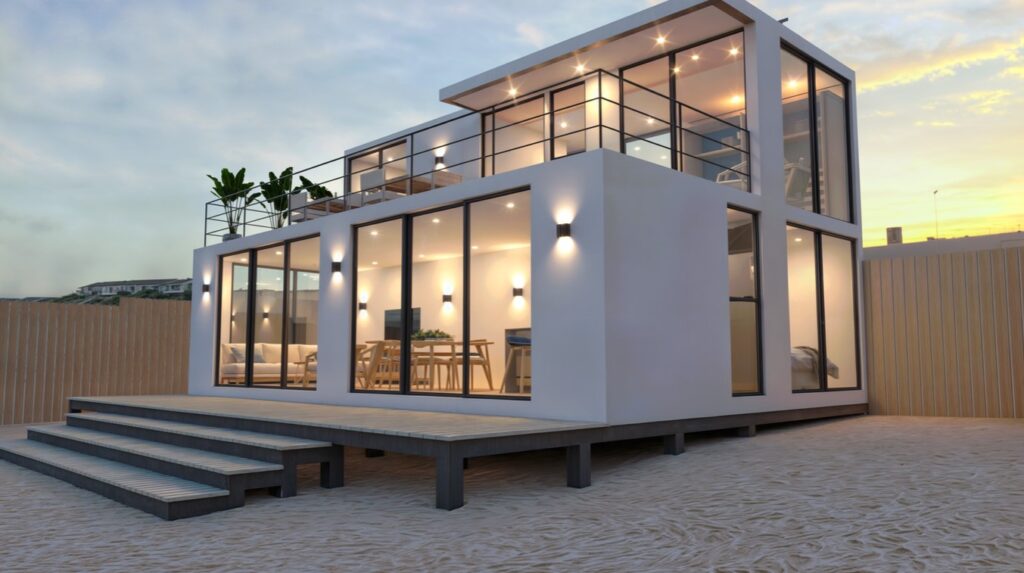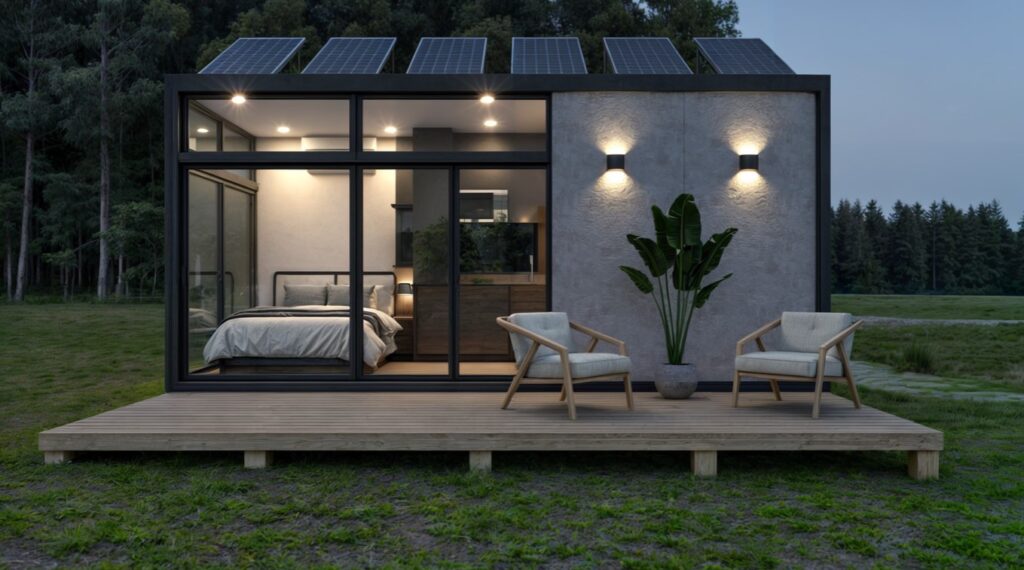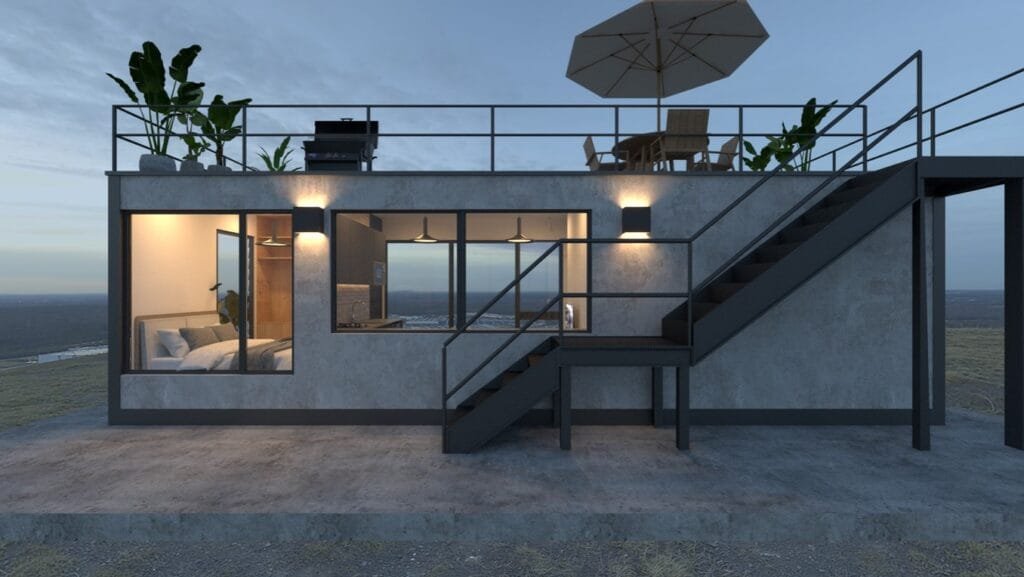As the world becomes more focused on sustainability, efficiency, and affordability, prefabricated housing has gained significant traction in the housing market. Prefab homes are no longer associated with cookie-cutter designs or temporary shelters.
Instead, they offer modern, innovative solutions for homeowners looking for cost-effective and environmentally friendly housing.
 Smartpod.mx offers their premium model “Smart House” which is 1065 square feet (99m2)
Smartpod.mx offers their premium model “Smart House” which is 1065 square feet (99m2)
Here are the top 10 reasons why you should consider prefab housing in 2025:
1. Cost Efficiency
Prefab homes are generally more affordable than traditional site-built homes. The controlled manufacturing process reduces waste, minimizes delays, and results in significant cost savings for buyers.
2. Faster Construction Time
With most of the work done offsite in a factory setting, prefab homes can be built and delivered in weeks rather than months, significantly reducing construction time compared to traditional methods.
3. Eco-Friendliness
The construction of prefab homes generates less waste, and many manufacturers use sustainable and recycled materials. Additionally, prefab designs often incorporate energy-efficient technologies like solar panels and advanced insulation.
4. Quality Control
Since prefab homes are built in a factory, the manufacturing process is subject to stringent quality controls. This ensures better construction standards, fewer defects, and improved durability.
5. Customization Options
Modern prefab housing offers a wide range of design and layout options, allowing homeowners to personalize their living spaces. Modular designs also make it easier to expand or alter the structure in the future.
6. Portability and Flexibility
Prefab homes can often be relocated, making them an excellent choice for people who anticipate moving or need a temporary yet high-quality living solution.
7. Resilience to Weather
Factories construct prefab homes in controlled environments, meaning the materials are not exposed to weather elements during the building process. This ensures durability and reduces risks of warping or damage.
8. Urban and Rural Applicability
Prefab housing works well in both urban and rural settings. In remote areas, prefab homes eliminate the logistical challenges and high costs of transporting construction materials and crews.
9. Advanced Technology Integration
Prefab homes in 2025 are designed with smart home integration in mind. They can include IoT devices, energy management systems, and other tech features to improve your quality of life.
10. Minimal Disruption
Because most of the construction occurs offsite, there is less noise, debris, and disruption at the home’s final location—making it an attractive option for established neighborhoods.
Revolutionizing Affordable Housing with SmartPod; The Future of Modular Living – YouTube
Top 5 Cons of Prefab Housing in 2025
While prefab homes have many benefits, they are not without their challenges. Here are the top five drawbacks to consider:
1. Upfront Costs for Customization
While base models are affordable, significant customization can drive up costs, sometimes approaching those of traditional site-built homes.
2. Transportation and Installation Challenges
Transporting large prefab components to the build site can be costly and logistically challenging, especially in areas with difficult access or strict regulations.
3. Limited Financing Options
Some banks and lenders may still view prefab homes as less conventional, making it harder to secure loans or mortgages compared to traditional homes.
4. Resale Value Uncertainty
The resale value of prefab homes may vary depending on local market perceptions and buyer preferences, which could make it harder to sell compared to traditional homes.
5. Zoning and Building Restrictions
Not all areas allow prefab housing or may impose strict zoning laws and permits, creating hurdles in the planning process.
 SmartPod.mx offers their studio which is 155 square feet (14.4m2), perfect for a BnB vacation rental or an extra building on your property for a family member
SmartPod.mx offers their studio which is 155 square feet (14.4m2), perfect for a BnB vacation rental or an extra building on your property for a family member
Prefab housing in 2025 is a strong contender for modern living, offering affordability, sustainability, and speed of construction. However, potential buyers should carefully weigh the cons, such as financing challenges and zoning restrictions, before committing.
Resources
 SmartPod.mx offers their “Tiny House” model with 30.3m2 (326 square feet)
SmartPod.mx offers their “Tiny House” model with 30.3m2 (326 square feet)
Charles Bivona Jr., aka Coach JP Money, is a business strategist, financial coach, and founder of CoachJPmoney.com. A lifelong entrepreneur, he launched his first real estate deal at 17 and went debt-free by 1998. Since then, he has built national media brands, advised small businesses, and helped clients grow online using smart strategy, digital tools, and creative grit.
An expat living in Baja, Mexico, Charles also writes and produces music as Johnny Punish and lives off-grid at Hacienda Eco-Domes, a sustainable retreat he built with his wife. Through providing small business services, coaching, writing, and podcasting, he’s on a mission to help others win their future—on their terms.
Read his full bio at PunishStudios.com >>>
Post Views: 63